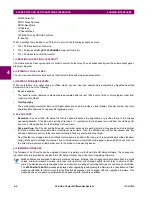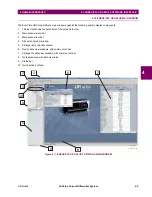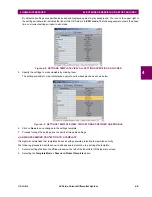
GE Multilin
L90 Line Current Differential System
3-31
3 HARDWARE
3.3 PILOT CHANNEL COMMUNICATIONS
3
3.3.5 RS422 INTERFACE
a) DESCRIPTION
There are three RS422 inter-relay communications modules available: single-channel RS422 (module 7T), dual-channel
RS422 (module 7W), and dual-channel dual-clock RS422 (module 7V). The modules can be configured to run at 64 or
128 kbps. AWG 24 twisted shielded pair cable is recommended for external connections. These modules are protected by
optically-isolated surge suppression devices.
The two-channel two-clock RS422 interface (module 7V) is intended for use with two independent channel banks
with two independent clocks. It is intended for situations where a single clock for both channels is not acceptable.
The shield pins (6a and 7b) are internally connected to the ground pin (8a). Proper shield termination is as follows:
•
Site 1: Terminate shield to pins 6a or 7b or both.
•
Site 2: Terminate shield to COM pin 2b.
Match the clock terminating impedance with the impedance of the line.
Figure 3–34: RS422 INTERFACE CONNECTIONS
The following figure shows the typical pin interconnection between two single-channel RS422 interfaces installed in slot W.
All pin interconnections are to be maintained for a connection to a multiplexer.
Figure 3–35: TYPICAL PIN INTERCONNECTION BETWEEN TWO RS422 INTERFACES
b) TWO-CHANNEL APPLICATION VIA MULTIPLEXERS
The RS422 interface can be used for single channel or two channel applications over SONET/SDH or multiplexed systems.
When used in single-channel applications, the RS422 interface links to higher order systems in a typical fashion observing
transmit (Tx), receive (Rx), and send timing (ST) connections. However, when used in two-channel applications, certain cri-
teria must be followed since there is one clock input for the two RS422 channels. The system functions correctly when the
following connections are observed and your data module has a terminal timing feature. Terminal timing is a common fea-
ture to most synchronous data units that allows the module to accept timing from an external source. Using the terminal
timing feature, two channel applications can be achieved if these connections are followed: The send timing outputs from
the multiplexer (data module 1), connects to the clock inputs of the UR–RS422 interface in the usual fashion. In addition,
the send timing outputs of data module 1 is also paralleled to the terminal timing inputs of data module 2. By using this con-
NOTE
~
~
~
~
~
~
~
~
~
~
~
~
~
~
Shield
Shield
COM
Tx +
Tx +
Tx –
Tx –
Rx –
Rx –
Rx +
Rx +
3b
5b
2a
4a
6a
7b
8b
Clock
RS422
channel 1
RS422
channel 2
Surge
3a
5a
4b
6b
7a
2b
8a
Int
er-r
elay
communications
7W
842776A3.CDR
Dual-channel RS422 module
~
~
~
~
~
Shield
Tx +
Tx –
Rx –
Rx +
3b
2a
6a
RS422
3a
4b
~
~
~
~
COM
8b
Clock
Surge
7a
2b
8a
Int
er-r
elay
comms.
7T
Single-channel RS422 module
~ indicates the slot position
Summary of Contents for UR Series L90
Page 652: ...A 16 L90 Line Current Differential System GE Multilin A 1 PARAMETER LISTS APPENDIX A A ...
Page 772: ...B 120 L90 Line Current Differential System GE Multilin B 4 MEMORY MAPPING APPENDIX B B ...
Page 802: ...C 30 L90 Line Current Differential System GE Multilin C 7 LOGICAL NODES APPENDIX C C ...
Page 812: ...D 10 L90 Line Current Differential System GE Multilin D 1 IEC 60870 5 104 APPENDIX D D ...
Page 824: ...E 12 L90 Line Current Differential System GE Multilin E 2 DNP POINT LISTS APPENDIX E E ...
Page 834: ...F 10 L90 Line Current Differential System GE Multilin F 3 WARRANTY APPENDIX F F ...
Page 846: ...xii L90 Line Current Differential System GE Multilin INDEX ...
















































